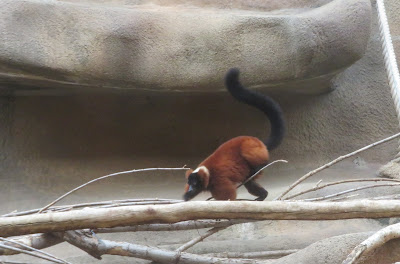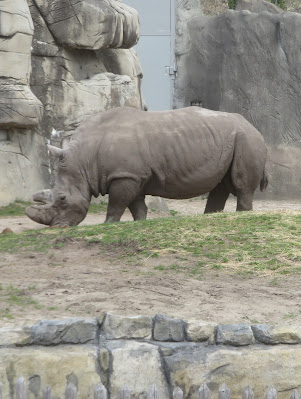Therefore I will describe the African habitats in two parts, and then the Arctic Habitat, and finally the ones we saw on our way out. Around the Flamingo habitat and wee walk you come to the African Lion habitat (L) with one Male and three female members in the Pride. The male, Simba, arrived at the Detroit in 2012 from the emirate of Qatar where he'd been owned by the Royal Family. Doing the math, he's at least 14, which is in the twilight years for a lion. Few live beyond 17 in captivity. The females Asha and Amirah are sisters who were both in 2016 and came to the zoo in 2019 under a SSP breeding recommendation. In 2020, Asha gave birth to Binti, the third female in the Pride. Binti's birth was the first at the Detroit Zoo since 1980.
Attached to the Lion Holding building is a habitat (M) with a large "mountain" feature home to a troop of Japanese Macaques. The original use of this habitat was probably for some other species as Macaque are not African, and there is no water feature which is a noted characteristic of Japanese Macaques--they have an affinity for water and swimming. The colony at the Detroit Zoo is 11 members strong.
Inside the holding building for the Lions and Macaques is a guest friendly passage with a standing Aviary, home to a flock of little black and white birds who's name I failed to copy down. Across from this is a large holding space with a "Stadium Seating" sort of rock wall with tree trunks and ropes and other opportunities for the inhabitants to exercise and explore. The space is more than two stories tall, with the lower portion out of sight of guests. The signage suggested that little groups of Ring-tailed and Red Ruffed Lemurs call the space home. We could here mucking around in the lower area, but only one of the Red Ruffed Lemurs ever made their way up into view. The zoo is home to two brothers who were born in 2018, so relatively young Lemurs. They share the space with four Ring-tailed Lemurs who were rescued from the illegal pet trade. Both species are endangered in the wild.
Across from the Macaques a separate habitat was home to a pair of Southern White Rhinoceros (N). The Detroit Zoo is home to a pair of males, Jasiri and Tamba. They are first White Rhinoceros that the Detroit Zoo has had in its collection. They arrived at the Detroit Zoo in 2005, Jasiri is 24 and Tamba is 23.














No comments:
Post a Comment